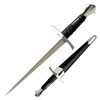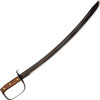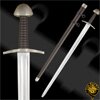|
|
|
 |
|
| Cold Steel Dagger Italian Dagger (88ITD) |
Points: 14
|
Since our Italian Long Sword is light and well balanced enough to use in one hand we thought we'd offer a companion dagger to take the place of a shield, targe, or buckler. Scaled down in size but almost identical in appearance, its sharply tapered, double edged blade slightly favors attacks with the point over the edge and is stiff and strong enough to parry any sword.
|
|
|
|
|
|
 |
|
| Cold Steel Talwar Saber (88EITB) |
Points: 18
|
Here at Cold Steel, we have been fascinated with the Talwar for decades, and we have made it our mission to bring the highest quality production version of this historically significant sword to the market.
|
|
|
|
|
|
 |
|
| Cold Steel Battle Gim (88FG) |
Points: 25
|
The Battle Gim is forged from our best DAMASCUS STEEL by talented smiths, it features a broad symmetrical point and a slightly wider, heavier blade than custom would dictate. This gives it a more pronounced blade-heavy balance making its twin razor-sharp edges slightly more suitable for cutting and slashing than thrusting.
The attractive Rosewood hilt is framed by a blackened iron guard and pommel. They're embellished with an intricate filigree of traditional Chinese Peony flowers and leaves. The matching Rosewood scabbard is styled in a similar fashion on its chape, throat and ring mounts.
|
|
|
|
|
|
 |
|
| Condor Naval Cutlass (CTK360-24HC) |
Points: 5
|
Condor Naval Cutlass features 24" curved blade made of 1075 high carbon steel a half basket guard.
Brown hardwood handles with black powder coated steel hand guard. Black leather belt sheath included.
|
|
|
|
|
|
 |
|
| Hanwei Tinker Pearce Norman Sword - Blunt (SH2427) |
Points: 10


|
The Tinker Norman sword pair, with their distinctive cruciform guard and brazil-nut pommel, are similar in weight and static balance and offer virtually identical handling characteristics. Both are harmonically balanced, optimizing the handling characteristics for the re-enactor in the case of this blunt version.
|
|
|
|
|
|
 |
|
| Hanwei Tinker Pearce Early Viking Sword - Blunt (SH2409) |
Points: 10


|
While not a direct copy of any particular sword, the Viking sword design was inspired by historical examples from the early 9th century, most notably finds from Trondheim, Norway, where the circular indentation hilt decoration was popular.
|
|
|
|
|
|
 |
|
| Red Dragon Stage Combat Sabre (WS-001) |
Points: 5


|
Our Red Dragon Stage Combat Sabre is the perfect starter weapon for stage combat and theatrical work. The durable bowl style hilt protects the hands from stray blows, whilst the flexible high carbon steel blade features a rolled tip for added safety.
|
|
|
|
|
|
 |
|
| Hanwei Practical Single-Hand Sword (SH2046) |
Points: 9

|
Our Practical Single-Hand sword is tailored to the needs of the re-enactor and very affordable. Featuring authentic hilt styling, with fully tempered un-edged and un-pointed blades, these swords are made to withstand rugged use while providing the level of safety required by many of today's re-enactment societies. It features a classically simple hilt, with a permanently-mounted grip and riveted tang for safety. The blade is fullered for balance and features 1/16" edges and a rounded tip. The scabbard is fabricated in a glass-filled resin, to provide great impact resistance, to eliminate swelling and to minimise blade corrosion problems.
Made for the re-enactor
Authentic look and feel
Complies with safety requirements
|
|
|
|
|
|
 |
|
| Hanwei Practical Hand-and-a-Half Sword (SH2106) |
Points: 10

|
Following in the footsteps of our SH2046 and SH2047 Practical Broadswords, the Practical Hand-and-a-Half adds another weapon to the re-enactor's repertoire. This very affordable piece features authentic hilt styling, with a fully tempered un-edged and un-pointed blade, and is made to withstand rugged use while providing the level of safety required by many of today's re-enactment societies. The grip is permanently mounted and the tang is riveted for safety. The blade is fullered for balance and features 1/16" edges and a rounded tip. The scabbard is fabricated in a glass-filled resin, to provide great impact resistance, to eliminate swelling and to minimise blade corrosion problems.
Made for the re-enactor
Authentic look and feel
Complies with safety requirements
|
|
|
|
|
|
 |
|
| Hanwei Practical Viking sword (SH2047) |
Points: 9

|
Our Practical Viking sword is tailored to the needs of the re-enactor and very affordable. Featuring authentic hilt styling, with fully tempered un-edged and un-pointed blades, these swords are made to withstand rugged use while providing the level of safety required by many of today's re-enactment societies. It features a classically simple hilt, with a permanently-mounted grip and riveted tang for safety. The blade is fullered for balance and features 1/16" edges and a rounded tip. The scabbard is fabricated in a glass-filled resin, to provide great impact resistance, to eliminate swelling and to minimise blade corrosion problems. The wood grain finish is attractive, but is left unfinished for owner customization.
Made for the re-enactor
Authentic look and feel
Complies with safety requirements
|
|
|
|
|
|
 |
|
| Hanwei Practical Norman (SH2326) |
Points: 8
|
An important addition to our European practical line is the Practical Norman sword, based on a classic 11th century pattern popular during the Norman Invasion of Britain. The high-carbon deeply-fullered blade is light and well-balanced, with the wide edges required by the re-enactment community. The guard is wider than that of the earlier Viking designs that preceded this pattern and the pommel is of the "tea-cosy" type The grip is grooved and leather-wrapped and the scabbard is left plain for owner decoration.
|
|
|
|
|
|
 |
|
| Hanwei Early Medieval Single Hand - Tinker Pearce Blunt Trainer (SH2405) |
Points: 15

|
The Blunt Trainer early medieval sword features nearly identical handling of its sharp companion, but with thick edges (2mm) and a rounded tip for safe sparring practice.
Tinker Pearce has developed these matching longswords to satisfy the need of every Western Martial Arts practitioner and sword enthusiast, to have a matching set of sharp and blunt swords for cutting and safe training practice. The swords meet Tinker`s exacting quality requirements and are built in much the same way as his custom pieces. Each blade is forged from 5160 Spring Steel, Marquenched to the desired hardness of 50-53 Hrc while the tang is drawn back to the low 30s Hrc. Teh very end of the tang is threaded to fit an allen nut recessed into the pommel which allows for dimantling of the hilt assembly for inspection or to exchange blades if needed.
What others are saying about the Tinker Pearce Longswords:
"I had the opportunity to handle the prototype Tinker Pearce Line Longswords by CAS/Hanwei, and they are beautiful, well-balanced, quick-handling swords at an excellent price. The sharp and blunt versions handle almost identically in cuts, thrusts, and quick posta (guard) transitions. These promise to be the mid-priced training weapon of choice for longsword studies."
Sean Hayes, Maestro d`armi, Northwest Fencing Academy and University of Oregon
|
|
|
|
|
|
|
|
Tags:
swords, sword, katana, wakizashi, tanto, japanese sword, medieval sword, viking sword, japanese swords, medieval swords, viking swords, knife, knives, saber, armour, movie swords, movie replicas, martial arts, sporting goods, sporting equipment,
|
















